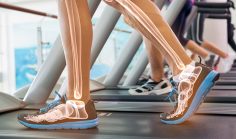Everything You Need to Know About Spinal Muscular Atrophy (SMA)

WHAT IS SPINAL MUSCULAR ATROPHY?
SMA is a rare genetic neuromuscular disease that affects the part of the nervous system that controls voluntary muscle movement. To understand this condition let’s deconstruct the name: “Spinal” refers to the loss of motor neurons that are located in the spinal cord.
“Muscular” refers to SMA’s primary effect on muscles, which are not receiving signals from motor neuron cells.
And “Atrophy,” the medical term for something that’s diminishing or wasting away – which is what happens to muscles when they’re not active. A hallmark of SMA is progressive muscle weakness and atrophy as muscles stop receiving signals from the central nervous system.

WHAT CAUSES SMA?
SMA is caused by a mutation in the surviaval motor neuron 1 – or SMN1 – gene; which is responsible for producing an SMN protein that maintains the health + function of motor neurons. So what happens in SMA? Both copies of the SMN1 gene are mutated in this condition – which leads to decreased production of the SMN protein. What does this mean? Simply put: muscles cannot receive clear signals from the brain, impeding muscular movement.

HOW IS SMA DIAGNOSED?
The first step is a physical exam and review of family history, and some simple tests to differentiate SMA from other similar conditions, like muscular dystrophy. The doctor may do a blood test, testing for an enzyme called creatinine kinas (CK) that leaks out of deteriorating muscles. If she suspects SMA, genetic testing will be recommended – which can be done via blood sample. It’s important to note, however, that genetic testing may have implications for the whole family – it’s advised to consult with a genetics counselor prior to testing.

WHAT ARE THE SYMPTOMS OF SMA?
There is a wide range of symptoms – from mild to severe. SMA is characterized by weakness of voluntary muscles – and the ones most affected tend to be those closest to the center of the body, like the: shoulders, upper back, hips, and thighs. And if the muscles of the back weaken, spinal curvatures typically occur. Sometimes, however, the muscles governing breathing and swallowing are affected, which can result in poor functioning of these processes.

WHEN DO SYMPTOMS BEGIN?
The severity of SMA symptoms is loosely correlated to when symptoms first appear: the earlier the age of onset, the greater the impact on motor function. Those who have symptoms at birth or infancy generally have the lowest level of functioning, whereas SMA onset in older children, teens or adults, typically correlates with increasingly higher levels of muscular functionality.

DOES SMA AFFECT COGNITIVE ABILITY?
It is believed that spinal muscular atrophy does not affect the neurons responsible for cognition. According to one study, children and adolescents with spinal muscular atrophy have normal intelligence, with IQs in the standard range. For school-age children, however, special accommodations may be needed to help maintain cognitive and intellectual engagement.

WHAT IS THE PROGRESSION OF SMA?
Doctors consider most cases of SMA to be on a continuum – preferring not to make firm predictions regarding muscle weakness or life expectancy based solely on age of onset. Having said that, the rough rule of thumb is that basically that the later the onset of the disease (and the more SMN protein there is) the milder that SMA will likely be.

IS SMA AN INHERITED DISEASE?
Yes. SMA follows what is known as an autosomal recessive inheritance pattern. Autosomes are the numbered pairs of chromosomes – all but the X and Y gender-determining chromosomes. Diseases that are recessive typically require two gene flaws – one from each parent. People who have only one gene flaw for a recessive disease are said to be carriers and usually show no symptoms. Often, a family has no idea that some members are carriers until a child is born with a recessive disorder. If both parents are carriers of the chromosome 5 SMA gene flaw, the risk of each pregnancy producing a child with the disease is 25 percent. Genetic testing for chromosome 5 SMA is available for those suspected of having the disease, including unborn babies, and for carriers of the disease.

LIVING WELL WITH SMA - HOW MUCH AND WHAT KINDS OF ACTIVITY ARE BEST?
Doctors advise doing as much physical activity as feels comfortable to maintain physical and psychological health + well-being. With SMA, it’s key to protect joints from stiffness or injury and to preserve flexibility in the joints. Exercising in a warm pool can be very beneficial – though a person with SMA should swim only with supervision as a precaution. Physical therapy and occupational therapy programs can help children and adults learn the best ways to maximize their muscle function and accomplish activities of daily living.

CUTTING EDGE RESEARCH – GENE THERAPY AND BEYOND
Research has focused on strategies to increase the body's production of SMN protein, lacking in the most common (chromosome 5-related) forms of the disease. One research strategy to treat chromosome 5-related SMA is based on transferring SMN1 genes into the body to raise the level of full-length SMN protein. In a 2010 U.S. experiment, very young mice with an SMA-like disease received intravenous injections of genes containing instructions for the SMN protein, which showed dramatic improvement of motor function and brain-to-muscle signaling, and a significant increase in survival










